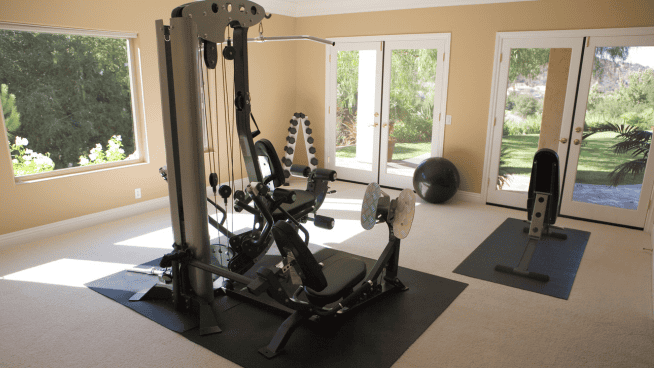Never Do a Plyometrics Cardio Circuit. Here’s Why.
Think your plyometrics cardio circuit is making you more powerful, improving your fitness and burning fat? Think again. What many people think of as a plyometrics workout looks nothing like the real thing. And if you’re not careful, it can cause injury.
That’s why you should avoid doing plyometric exercises in high-intensity circuits, such as a Tabata circuit. To understand why plyometric cardio circuits are not good, you need to know about the origin of plyometrics.
Developed by Soviet scientist Dr. Yuri Verkhoshansky in the 1960s and 1970s, the original plyometric exercise was the Depth Jump. Verkhoshansky called it “shock training,” because it involved landing from an elevated surface, impact with the ground (the shock) and a subsequent explosive jump.
This exercise, along with many other fantastic plyo exercises such as Box Jumps and Skater Jumps, train the stretch-shortening cycle, a process that occurs in your muscles when your body rapidly changes directions, such as when landing from a jump and jumping up again.
When your body comes into contact with the ground, your muscles lengthen to decelerate your body. The force from the landing is stored as elastic energy. At the bottom of the landing, your muscles make a quick transition—no more than 25 milliseconds—before releasing the stored elastic energy to propel you into the air.
But just because you’re jumping doesn’t mean you’re doing a plyometric exercise. In fact, performing plyometric exercises in a cardio circuit all but guarantees the movements aren’t plyometric—and they won’t make you more powerful. It all comes down to fatigue.
RELATED: Everything Wrong With P90X Plyometrics
Why Fatigue Ruins Plyometric Workouts
Plyometric exercises are meant to be done with max force in as little time as possible. You achieve this by performing 3 to 6 sets of 3 to 8 powerful and clean reps. The exact numbers depend on the type of exercise and where you are in your training. You should take about 30 seconds of rest between sets to recover.
This allows you to spend less time on the ground between jumps. Your transition speed is faster, and less elastic energy is wasted as heat, making for more powerful movements. The rest interval enables your energy systems to fully recover so you can give your max effort with every rep—the key to increasing your vertical and getting more powerful.
Workouts structured like this challenge your body, but not in the sense that you’ll be gasping for air and leaning on your knees.
“Fatigue from a true plyometric workout is primarily neurological,” explains Brandon McGill, sports performance director at STACK Sports Performance Training. “At the end of a plyo workout, you might feel a little sluggish and not as responsive. The next day your legs are going to feel heavy.”
RELATED: 10 Best Plyometric Exercises for Athletes
Plyometric conditioning circuits are designed to cause fatigue—the exact opposite of what you want in a proper plyo workout. Because you’re tired, you spend too much time on the ground, and all your elastic energy is lost as heat. As you fatigue, you quickly lose power.
Does this help you get in shape? Sure. Repeatedly jumping is tough, and it challenges your conditioning. But this can lead to . . .
Poor Technique and an Increased Risk for Injury
When you get tired, the first thing that breaks down is your technique. It simply becomes impossible to do every rep perfectly.
Plyometrics—and every exercise, for that matter—should always be performed with perfect technique. But poor technique is especially problematic for plyometrics, because of the stress from the movements.
Every time you land from a jump, your joints absorb significant impact forces. A proper plyometric workout calls for only 75 to 150 touches, or reps—to minimize the stress from landing so it doesn’t lead to an injury.
Plyometric conditioning workouts don’t account for this. You are typically encouraged to do as many reps as you can to maximize the conditioning effect.
As your technique breaks down, the stress increases. Your landings gradually become harder and louder—quiet landings are critical for plyo workouts—and those jarring impact forces will be absorbed by your joints rather than your muscles. Other form cues, like keeping your chest up, quickly go out the window when you’re tired.
What Should You Do?
Put simply, plyometrics and conditioning are completely opposing styles of training and do not go well together. If you want to get powerful, do a proper plyometric workout. If you want to get in shape, do a conditioning workout such as Tempo Runs or high-intensity strength circuits that don’t involve impact with the ground.
RECOMMENDED FOR YOU
Never Do a Plyometrics Cardio Circuit. Here’s Why.
Think your plyometrics cardio circuit is making you more powerful, improving your fitness and burning fat? Think again. What many people think of as a plyometrics workout looks nothing like the real thing. And if you’re not careful, it can cause injury.
That’s why you should avoid doing plyometric exercises in high-intensity circuits, such as a Tabata circuit. To understand why plyometric cardio circuits are not good, you need to know about the origin of plyometrics.
Developed by Soviet scientist Dr. Yuri Verkhoshansky in the 1960s and 1970s, the original plyometric exercise was the Depth Jump. Verkhoshansky called it “shock training,” because it involved landing from an elevated surface, impact with the ground (the shock) and a subsequent explosive jump.
This exercise, along with many other fantastic plyo exercises such as Box Jumps and Skater Jumps, train the stretch-shortening cycle, a process that occurs in your muscles when your body rapidly changes directions, such as when landing from a jump and jumping up again.
When your body comes into contact with the ground, your muscles lengthen to decelerate your body. The force from the landing is stored as elastic energy. At the bottom of the landing, your muscles make a quick transition—no more than 25 milliseconds—before releasing the stored elastic energy to propel you into the air.
But just because you’re jumping doesn’t mean you’re doing a plyometric exercise. In fact, performing plyometric exercises in a cardio circuit all but guarantees the movements aren’t plyometric—and they won’t make you more powerful. It all comes down to fatigue.
RELATED: Everything Wrong With P90X Plyometrics
Why Fatigue Ruins Plyometric Workouts
Plyometric exercises are meant to be done with max force in as little time as possible. You achieve this by performing 3 to 6 sets of 3 to 8 powerful and clean reps. The exact numbers depend on the type of exercise and where you are in your training. You should take about 30 seconds of rest between sets to recover.
This allows you to spend less time on the ground between jumps. Your transition speed is faster, and less elastic energy is wasted as heat, making for more powerful movements. The rest interval enables your energy systems to fully recover so you can give your max effort with every rep—the key to increasing your vertical and getting more powerful.
Workouts structured like this challenge your body, but not in the sense that you’ll be gasping for air and leaning on your knees.
“Fatigue from a true plyometric workout is primarily neurological,” explains Brandon McGill, sports performance director at STACK Sports Performance Training. “At the end of a plyo workout, you might feel a little sluggish and not as responsive. The next day your legs are going to feel heavy.”
RELATED: 10 Best Plyometric Exercises for Athletes
Plyometric conditioning circuits are designed to cause fatigue—the exact opposite of what you want in a proper plyo workout. Because you’re tired, you spend too much time on the ground, and all your elastic energy is lost as heat. As you fatigue, you quickly lose power.
Does this help you get in shape? Sure. Repeatedly jumping is tough, and it challenges your conditioning. But this can lead to . . .
Poor Technique and an Increased Risk for Injury
When you get tired, the first thing that breaks down is your technique. It simply becomes impossible to do every rep perfectly.
Plyometrics—and every exercise, for that matter—should always be performed with perfect technique. But poor technique is especially problematic for plyometrics, because of the stress from the movements.
Every time you land from a jump, your joints absorb significant impact forces. A proper plyometric workout calls for only 75 to 150 touches, or reps—to minimize the stress from landing so it doesn’t lead to an injury.
Plyometric conditioning workouts don’t account for this. You are typically encouraged to do as many reps as you can to maximize the conditioning effect.
As your technique breaks down, the stress increases. Your landings gradually become harder and louder—quiet landings are critical for plyo workouts—and those jarring impact forces will be absorbed by your joints rather than your muscles. Other form cues, like keeping your chest up, quickly go out the window when you’re tired.
What Should You Do?
Put simply, plyometrics and conditioning are completely opposing styles of training and do not go well together. If you want to get powerful, do a proper plyometric workout. If you want to get in shape, do a conditioning workout such as Tempo Runs or high-intensity strength circuits that don’t involve impact with the ground.













